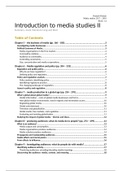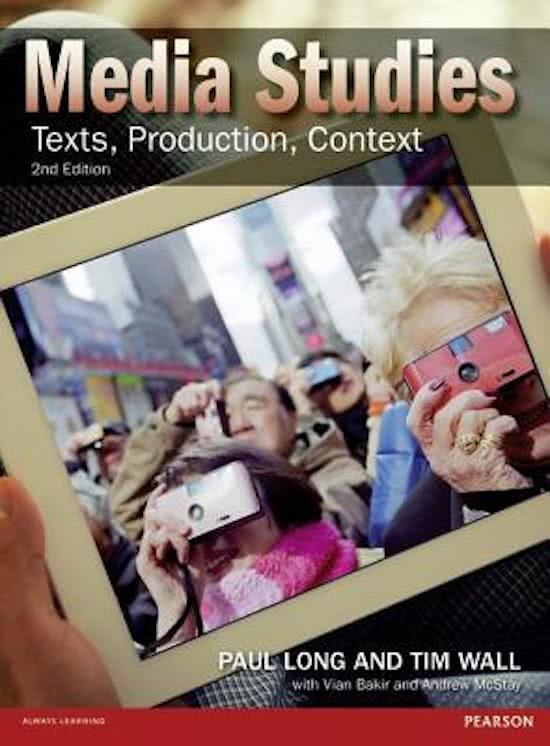Hannah Homan
Media studies 2017 – 2018
Block 1.4
Introduction to media studies II
Summary, exam literature Long and Wall
Table of Contents
Chapter 5 – the business of media (pp. 166 – 185)..............................................................3
Investigating media businesses....................................................................................................3
Political Economc of Meedia..........................................................................................................3
Media organisatons in tthe Free market.......................................................................................4
Commodity relatons.....................................................................................................................4
Audience as commodity................................................................................................................4
Controlling uncertainty.................................................................................................................5
Size, concentraton and media corporatons.................................................................................5
Chapter 6 – Meedia regulation and policc (pp. 204 – 232)....................................................6
Regulation and public policc.........................................................................................................6
Wthy do we thave regulatonn........................................................................................................6
Defining policy and regulaton......................................................................................................7
Policc and regulation analcsis.......................................................................................................7
Policy analysis: identiying policy..................................................................................................7
Identiying regulatory practce......................................................................................................8
Tthe cthanging landscape oi regulaton...........................................................................................8
Issues in policc and regulation......................................................................................................8
Chapter 7 – media production in a global age (pp. 234 – 270).............................................9
What’s global about global media?..............................................................................................9
Global iniormaton roots oi global media businesses and iorms...............................................9
New global media environments, searcth engines and iniormaton access.................................10
Regulatng global media..............................................................................................................10
Global entertainment..................................................................................................................10
Television and globalisaton........................................................................................................11
Global media, iree markets, and regulaton................................................................................11
Evaluatng and resistng globalisaton.........................................................................................11
Studcing the impact of global media – themes and ideas...........................................................12
Chapter 8 – producing audiences: what do media do to people? (pp. 274 – 299)..............13
What is an audience?.................................................................................................................13
Media output and consumpton.................................................................................................13
Media organisatons produce audiences.....................................................................................14
Media sctholars produce audiences.............................................................................................14
Propaganda and manipulating audiences...................................................................................15
Meedia efects and moral panics..................................................................................................15
From efects to infuence............................................................................................................16
Chapter 9 – investigating audiences: what do people do with media?..............................17
Identifcing audience activitc.......................................................................................................17
Ttheorising audiences: encoding/decoding media meanings.......................................................18
Discovering the audience: media, context, and meaning............................................................18
, Subcultures and iandom.............................................................................................................19
online audience actvity: creatng communites, meaning, and identty.....................................20
Researching media audiences.....................................................................................................22
Metthodologies............................................................................................................................22
Questonnaires and interviews....................................................................................................22
Focus groups...............................................................................................................................22
Etthnograpthy................................................................................................................................22
Ethics and audience research......................................................................................................23
Read through conclusion once (pp. 482 - ?)......................................................................23
,Chapter 5 – the business of media (pp. 166 – 185)
Investigating media businesses
We barely ever think about who is behind media, as it seems that they are often ‘just there’.
Media studies sometimes have romantic ideas of how media products are produced, in reality
however, media as highly organised business are those in which creative and managerial staff
have a responsibility to create content for specific audiences on a regular cycle and to a
certain budget. The current organisation of media products is not obvious in two senses:
1. There is substantial variety in the nature of organisations that produce media products
2. It is not always clear who actually made any given media product
Furthermore, although media products are often heavily branded, those brands sometimes
disguise who actually produced or distributed them to us (whether this was an individual,
collective, or company). All media organisations are businesses involved in a commercial
sphere of exchange, of income generation, of profit and loss. So, although all forms of media
organisation operate in a similar economic environment, they will respond to this
environment in different ways.
There are three main approaches that have been developed to study the three different
levels at which we can understand media operations operating.
1. Political economy: looks at the place of media businesses in the wider world
of economics and politics (most important in the literature!!)
2. Organisational study: is interested in the detailed structure and objectives of
organisation
3. Workplace ethnography: looks at the culture of media workers in their
organisation, exploring the ideas of professionalism, skill, creativity, and
views of audiences they operate with
Political Economy of Media
Vincent Mosco has defined political economy as:
‘the study of the social relations, particularly the power relations, that mutually constitute
the production, distribution, and consumption of resources’
His definition points to the need to study the ways in which media products are made,
circulated and experiences, and how powerful the different people involved are and what part
they play in the processes. Therefore, political economy approaches have sought to
investigate the conditions under which media institutions and organisations are formed and
work, as well as the incentives and constraints under which they operate.
Historically, the political economy approach has been concerned with questions such
as: who pays for media at the point of production? What is the primary commodity of any
medium? And how do consumers pay for this commodity and for the different economic
activities of media? As a result, media researchers have explored questions of power within
the framework of what has been called a ‘critical political economy’. The critical aspect is
, brought to bear upon the nature of states and governments and the way they oversee media
management and regulation, and the nature of the wider capitalist economy which
underwrites the profit impulse of media businesses in relation to wider participatory politics.
Murdock and Golding: it constitutes an approach in which we must engage with basic
moral questions of justice, equality, and the public good. Fundamental questions arise from
an acceptance of centrality of media in modern societies and concern the concentration of
media ownership, the way that media are organised and the degree to which such factors
impact upon the management of society in general, and upon all us individuals.
Media organisations in the Free market
The term ‘free market’ describes a condition where a business is governed
by laws of supply and demand, rather than by government interference,
regulations or subsidies. Supply and demand suggests a relational and
dynamic model where the price of a good in a competitive market will
impact upon the degree of demand from consumers and the response of the
producers.
One of the features of the landscape of media businesses in a capitalist economy is that of
competition. Media organisations compete with each other for audiences, sales and revenue
streams, such a as advertising, in order to maximise profits. They compete by offering
varieties of the same thing, the same thing again and again, or attempting to innovate and
forge new audiences, attracting them away from their habitual pleasures and habits. In a free
market economy, scarcities of commodities are resolved through changes in relative prices.
Commodity relations
Economic value defines the commodity form of any medium and its outputs, and these
outputs cost money to produce and, in turn, are used to create revenue for the companies that
produce them. Nonetheless, media products are different from other products because of the
combination of the way that they generate revenue and the way they are consumed. Revenue
can come from two sources:
1. Directly from the final consumers, made in some form of payment for a physical
artefact or a subscription.
2. Selling space in the physical artefact to advertisers, who wish to communicate with
the audience.
In addition: media products are usually not characterised by repeat purchases.
Audience as commodity
Dallas Smythe (1981) argued that we should not think of media organisations as
producing media products, but rather as producing audiences. From this perspective the
news stories, websites and programmes are the way that they are because they are aimed at
attracting the particular audience that a group of advertisers want.
- Optimistically, this should ensure that different groups of people get products targeted
at their tastes and interests.






